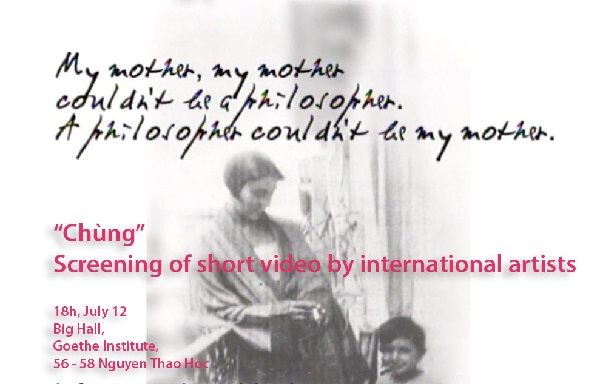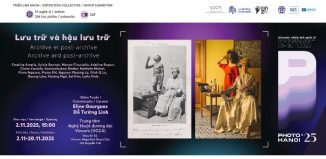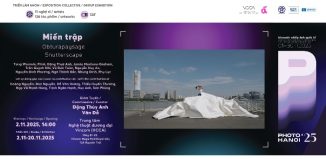Screening of “Chùng” – Short Videos by International Artists
Sat 12 Jul 2014, 6 pm
DOCLAB
From DOCLAB:
Hanoi Doclab, Nối Projects, and Video Data Bank present short video by international artists from the collection of the Video Data Bank:
· Light house by Chi Jang Yin, 2009, 16’15, US
· Track one by eTeam, 2011, 1’45, Taiwan
· Time passes by Nelson Henricks, 1998, 6’34, Canada
· Epilogue: The Palpable Invisibility of Life by Tran T. Kim-Trang, 2006, 13’27, US
· Annie Lloyd by Cecilia Condit, 2008, 18’15, US
‘Chùng’ is an adjective in Vietnamese language that refers to a deceleration, and also to moments of contemplation to think deeply. In our daily life, everything seems to pass by so quickly that we hardly find a moment to reflect and contemplate about something deeply. These rare moments of contemplation are revealed in video works of the series through the view of the artists.
After screening there will have a Q&A session with Nhung from Nối project.
Duration : 56 minutes
Language : English
Light house by Chi Jang Yin, 2009, 16’15
Lighthouse is about the labor system and the factory town in Southern China and how individualism is influenced by the social and political infrastructure. Guangdong District is the largest Metropolitan area in one of China’s wealthiest provinces, and one of its cities, Guangzhou, attracts farmers from the countryside looking for factory work. The viewer is led to actively compose narratives through the poetic and the sublime images. It opens borders that separate cultural, linguistic and historical differences in the global labor systems.
Chinese-born media artist Chi Jang Yin is known for her conceptual, documentary work, which comments upon the state of Chinese culture, past and present. She often imbues her work with elements from her background in photography and performance art. She received her BA and her MFA from the School of the Art Institute of Chicago in 2000. Her videos were recently awarded Honorable Mention at the In-Out Festival, Poland; Best Film on Architecture at the Asolo Art Film Festival, Italy; and Second Grand Prize at the Athens International Film Festival, Ohio. Her work has screened at the 2008 Asian Art Biennial at the Taiwan National Museum of Fine Arts, Taichung, the Los Angeles Film Festival, and the International Documentary Festival Amsterdam (IDFA).
Track one by eTeam, 2011, 1’45, Taiwan
The time is now! The present can be replaced in real time. Not quite yet by the future, but very easily by the past? eteam’s video Track One is a replay of such time disjuncture. As they keep following the memory of a yellow cab that keeps driving through the now deserted streets of Taipei, their pastime augments itself with a mesmerizing sense of reality.
About e-Team: Since 2001 Franziska Lamprecht and Hajoe Moderegger have been collaborating under the name eteam. Most of their projects are based on random pieces of land they buy on ebay or in Second Life. eteam’s projects have been featured at many venues, including Art in General, P.S.1, and Eyebeam in New York, MUMOK in Vienna, Neues Museum Weimar in Germany, The Nelson Atkins Museum of Art in Kansas City, and the Museo Nacional Centro de Arte Reina Sofia in Spain. eteam’s videos have been screened at the Transmediale in Berlin, the Taiwan International Documentary Festival in Taipei, the New York Video Festival, and the 11th Biennale of Moving Images in Geneva. Moderegger and Lamprecht have received funding for their work from Art in General, NYSCA, Rhizome, the Experimental Television Center, the Henry Moore Foundation, and an Emerging Artist Fellowship Grant from Socrates Sculpture Park in Queens. They have been awarded residencies at the MacDowell Colony, Yaddo, Smack Mellon, Eyebeam, Harvestworks and the Center for Land Use Interpretation. Most recently they have been awarded a Creative Capital Grant for their project open source Grabeland.
Winners of the Videoförderkunstpreis Bremen, 2008/09.
Time pass by Nelson Henricks, 1998, 6’34
Using a Super-8 camera, Henricks employs time-lapse photography to document the interior and exterior of his apartment. Inspired by the work of Virginia Woolf, Time Passes uses writing as a metaphor for notions of temporality and impermanence.
Nelson Henricks was born in 1963 in Bow Island, Alberta and is a graduate of the Alberta College of Art. He moved to Montréal in 1991 and received a BFA from Concordia University, where he now teaches. Henricks has also taught at the Université de Québec à Montréal and McGill University. A musician, writer, curator and artist, Henricks is best known for his videotapes, which have been exhibited worldwide. A focus on his videowork was presented at the Museum of Modern Art in New York as part of the Video Viewpoints series. His writings have been published in Fuse, Public and Coil magazines, and in the anthologies So, To Speak (Editions Artexte, 1999) and Lux (YYZ Press, 2000). Henricks co-edited an anthology of artists’ video scripts entitled By the Skin of Their Tongues (YYZ Press, 1997) with Steve Reinke.
Recipient of the Bell Canada Award in Video Art, 2002
Epilogue: The Palpable Invisibility of Life by Tran T. Kim-Trang, 2006, 13’27
How can we make visible the invisible? How can we “see” our lost loved ones? In EPILOGUE, Vietnamese-American filmmaker Tran T. Kim Trang looks for answers to these questions in the audio recordings of her dead mother, the handwriting of the late French philosopher Jacques Derrida and the ultrasound photos of her newborn baby. Finding no ready-made answers, Tran invites us to reflect about life and death in this moving video essay about motherhood and mourning. EPILOGUE is the eight and final installment of Tran’s THE BLINDNESS SERIES.
“When Derrida died in 2004, EPILOGUE shifted focus from his work on mourning to ruminate on 1) the visible and invisible traces one leaves behind: a font made from Derrida’s infamous handwriting, my mother’s dying words, etc.; 2) the cycle of life and death: my son’s birth on the same day, date, and time as my mother’s death six years prior; and 3) imaging technologies that allowed one to see an unborn child, leading to fantasies about what technologies it would take to ‘image’ an incorporeal mother, and discovering that ancient medicine can bring a daughter closer to her dead mother.” —TRAN T. Kim-Trang
About Tran, T. Kim-Trang: Tran was born in Viet Nam and emigrated to the U.S. in 1975. She received her MFA from the California Institute of the Arts and has been producing experimental videos since the early 1990s. Her work has been exhibited internationally. In 1999 Tran presented her Blindness Series in a solo screening at the Museum of Modern Art. Two of her videos were included in the Biennial exhibition at the Whitney Museum of American Art, and the Blindness Series was featured at the 46th Robert Flaherty Film Seminar, both in 2000. Her video project, an eight-video series investigating blindness and its metaphors was completed in 2006. Tran has been nominated for a Cal Arts/Alpert Award in the Arts and was named a 2001 Rockefeller Film/Video/Multimedia Fellow. The fellowship has enabled her to develop an experimental narrative feature titled Call Me Sugar, based on the life of her mother.
Tran also collaborates with Karl Mihail on a project known as Gene Genies Worldwide© (genegenies.com). Their conceptual and public artworks on genetic engineering have exhibited at the Ars Electronica Festival in Austria, Exit Art, the Tang Museum at Skidmore College, and elsewhere in the U.S. She is currently an Associate Professor of Art at Scripps College.
Annie Lloyd by Cecilia Condit, 2008, 18’15
Annie Lloyd is a daughter’s poetic documentation of the last few years of her mother’s life and an intimate portrayal of the creativity and wisdom of old age.
Annie Lloyd is a vivid and powerful old woman who collects leaves and revels in the wonders of the world. She also happens to be the filmmaker’s mother — making this an intimate tale of a mother and daughter celebrating life, love, and creativity in the very jaws of the dying process. This short film, by the award-winning experimental filmmaker Cecelia Condit, explores issues of aging, mortality, mother-daughter relationships, and late-life love and creativity.
Born 1947 – Philadelphia, PA. Cecelia Condit studied sculpture at the Pennsylvania Academy of Fine Arts, received a B.F.A. in sculpture at the Philadelphia College of Art, and a M.F.A. in photography from Tyler School of Art, Philadelphia, PA. Her work has been shown internationally in museums, galleries, alternative spaces and festivals and is represented in many public and private collections including the Museum of Modern Art in NYC, Centre Georges Pompidou, Musee National d’Art Moderne, Paris, France, the Carnegie Museum of Art, Pittsburgh and the Polaroid Corporation. In the past 30 years, she has received numerous awards including grants from the Guggenheim Foundation, the American Film Institute, the National Endowment for the Arts and the Mary L. Nohl Foundation and the Wisconsin Arts Board. She is currently professor and director of graduate studies in the Department of Film/Video/Animation/New Genres at the University of Wisconsin-Milwaukee.
Since the early 1980s Cecelia Condit’s narrative tapes have explored the not-so-average experiences of the “average woman” in a social climate of sublimated violence, fear, and misogynist aggression. Her dark-humored works conflate fairy tale morals with the grisly sensationalism of tabloid headlines, incorporating live action, appropriated television images, and original music into frequently operatic narratives. Condit is a Professor of Film and Video at the University of Wisconsin-Milwaukee.
“My work centers around the theme of how bizarre events disrupt mundane lives. By contrasting the commonplace with the macabre, humor with the absurd, I address a reality that is both surprisingly believable yet strange enough to belong only to the realm of fiction.”
–Cecelia Condit
Mary L. Nohl Fellowship, Greater Milwaukee Foundation, 2005
About Video Data Bank: Founded at the School of the Art Institute of Chicago (SAIC) in 1976 at the inception of the media arts movement, the Video Data Bank (VDB) is a leading resource in the United States for video by and about contemporary artists. The VDB Collection includes the work of more than 550 artists and 5,500 video art titles, 2,500+ in active distribution. The VDB makes its Collection available to museums, galleries, educational institutions, libraries, cultural institutions and exhibitors through a national and international distribution service, and works to foster a deeper understanding of video art, and to broaden access and exposure to media art histories through its programs and activities. These include preservation of historically important works of video art, the perpetuation of analog and digital archives, publishing of curated programs and artists’ monographs, the commissioning of essays and texts that contextualize artists’ work, and an extensive range of public programs. Operating under SAIC’s not-for-profit status, the VDB is supported in part by a grant from the Illinois Arts Council Agency.
If you’re interested in getting news, announcements from DOCLAB for its activities, workshops, and schedule of film screenings, etc., please email us at [email protected] to subscribe to DOCLAB news.
 | DOCLAB Goethe-Institut Hanoi 56-58 Nguyễn Thái Học Ba Đình, Hà Nội http://www.hanoidoclab.org |














